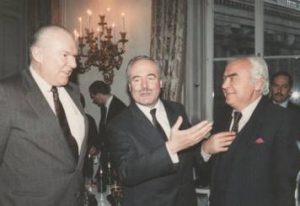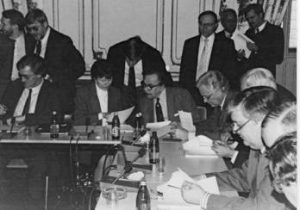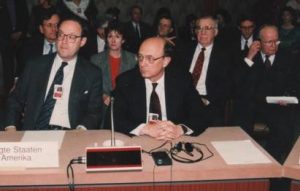A Master Translator Who Influenced a major Treaty
by Janet Andres
On July 14, President Putin announced that Russia was withdrawing from the Conventional Armed Forces in Europe (CFE) Treaty. The terms of the Treaty require 150 days notice for withdrawal, and the parties have already met in Vienna (where it was signed in 1990) to discuss differences; a Russian spokesman said they have not closed the door on CFE.
We are pleased to present a timely article by the political counselor of the U.S. delegation to the NATO-Warsaw Pact negotiations that produced the CFE Treaty, a major arms control agreement concluded in the waning days of the Cold War. She gives us some of the fascinating background to these talks, including the important role of State Department master translator Alexis Obolensky. She calls this exiled White Russian prince a linguist of amazing ability as well as an eccentric and an original who was sometimes irritating but never dull.—Ed .
Vienna, 1990
We didn’t know then that in just a little over a year the Soviet Union itself would dissolve, but we could see that the sun was clearly setting on its East European empire—a development that gratified us as Cold Warriors but worried us as negotiators. Since 1973, NATO and the Warsaw Pact had been trying to put together an agreement in Vienna that would reduce and limit conventional forces in Europe. Throughout the long deep-freeze years of East-West confrontation, the sides met religiously to talk at one another but little progress was made. Then, in the mid-1980s, along came Gorbachev, perestroika, and glasnost, and between 1987 and early 1989, a mandate for a new conventional arms control forum to replace the old Mutual and Balanced Force Reduction talks (MBFR) was hammered out.
The Negotiation on Conventional Armed Forces in Europe (CFE) was opened in March, 1989, by foreign ministers, including the new U.S. Secretary of State, James Baker. (Those who like acronyms will note that we might have referred to these as the CAFÉ talks, but despite the whimsical allure—we were, after all, in Vienna—it was feared such a label would call into question the seriousness and dynamism of the new forum.)
Even during the mandate talks there had been rumblings of independence on the eastern side, fomented by Hungary, and it was obvious that if we wanted to take advantage of the structure and discipline afforded by a bloc-to-bloc negotiation, we would have to move at a much faster pace than we had during MBFR.

The events of that momentous year, 1989, played out not only at the negotiating table but also in the streets of Vienna. First came the Hungarians as Budapest began to ease open its border with Austria. These poor relations of the Habsburg Reich were interested not so much in marveling at the stunning palaces, gardens, and museums of the old imperial capital, but rather headed straight for the main shopping district where they clogged the streets and scarfed up vast quantities of TVs, VCRs, and other consumer goods so long denied them. (A favorite quip at the time was “the empire strikes back.”) The Czechs and Slovaks came next, and finally, East Germans who had their government’s permission to go to Hungary on vacation but who then slipped over the increasingly porous border. Other East European refugees also made it to Vienna over the Hungarian border during this period, including Romanian gymnastic legend Nadia Comaneci, who was promptly granted asylum in the United States. In November, the die was inexorably cast with the fall of the Berlin Wall.
Fading Communists
All of CFE’s 23 original negotiating countries were still at the table throughout much of 1990, but the German Democratic Republic was fading fast (German unification would take place in October, 1990) and some East European capitals had already sent brand new negotiating delegations to Vienna. They were fresh and enthusiastic, but had limited understanding of multinational negotiating, to say nothing of tanks and artillery. Some of the old Communists were still in the chair, protected by their arcane expertise, but — bewildered by the rapid changes and unsure how to deal with their new democratic masters — they were keeping their heads down. Working with the East Europeans was becoming ever more difficult. We could no longer look to the Soviets to speak authoritatively for their erstwhile satellites.
We were in the strange position of encouraging Warsaw Pact solidarity—but just long enough to complete the treaty and win the signatures of the individual countries. While the negotiating structure was bloc-to-bloc, each state was making individual commitments relative to its own weapon systems, commitments it would retain in a new Pact-less Europe.
Several months into 1990, our political leaders set a deadline: the CFE treaty was to be signed on November 19, 1990, the same day as the broader Paris Charter of the Conference on Security and Cooperation in Europe (CSCE).
As if the task of finalizing complex provisions governing thousands upon thousands of tanks, artillery pieces, armored combat vehicles, combat aircraft, and attack helicopters over a matter of months was not overwhelming enough, the treaty and its multiple protocols (ultimately filling 110 single-spaced printed pages) had to be in six different languages.
For the United States, concluding CFE on time was an all-out effort by multiple agencies; during 1990, the U.S. delegation swelled from a few dozen to more than eighty people.
Not-So-Secret Weapon: The Prince
One of our not-so-secret weapons in the race to finish was a slight, dapper State Department translator named Alexis Obolensky. The head of the Russian translation section of Language Services, Alexis’ aristocratic White Russian parents had fled their vast estate shortly after the 1917 Revolution. Alexis, born in 1919 in German exile, grew up in Italy. After receiving a doctorate in law at the University of Rome and working for a time as head of the Russian broadcasting section of Italian state radio, he met and married an American studying opera in Rome and eventually moved to the United States and became a citizen. He joined the State Department in the 1970s after a stint at the Commerce Department.

A skilled translator, fluent in multiple languages, Alexis was much in demand, but he spent lengthy periods with us, drawn certainly by the importance of the mission and the professional challenge, but also by Vienna. It was a city where the past had always been embraced much more fervently than the present and a title—even with no power or money attached—afforded special entrée.
Alexis was also a formidable negotiator. As anyone who has ever worked on an international agreement or even a communiqué knows, one can debate endlessly the nuances of individual words and phrases. CFE, given its topic and number of participants and languages, was debate on steroids. Since each text would be considered equally valid and binding once the treaty was signed, it was vital that the translations accurately reflect the agreed draft (which thankfully was in English). While the delegations whose languages were among the official six cared deeply about their “own” version of the treaty (that was the one their political masters would scrutinize), most of the negotiating countries were not particularly interested in the other translations, nor did they have professional linguists available. A British translator provided some valuable assistance but for the most part, the burden of ensuring that the translations were accurate was on the Prince.
As the hectic days of 1990 slipped by and we chipped away at the hundreds of remaining substantive issues, the Prince began appraising and dissecting other delegations’ renditions into Russian, Italian, Spanish, German, and French of the English text approved so far. He managed the process admirably and ran into very few roadblocks. His linguistic skills were impressive, but it was his self-confidence and aristocratic hauteur that tended to cow his interlocutors.
The Prince Meets His Match
It had not always been so. In early 1989, when Alexis was in Vienna to examine the translations of the CFE mandate, he had met his match in the equally talented, confident, and determined head of the French delegation, a woman named Salome Zourabishvili whose family came from Georgia, in the Caucasus. She had been a tenacious negotiator during the drafting of the mandate, working in particular to dilute the bloc-to-bloc character of the upcoming talks and, if possible, to subjugate CFE to the broader CSCE forum. (France had been an ambivalent NATO member ever since withdrawing from the integrated military command in 1966.) For us, CSCE authority over CFE was a non-starter; decisions on the limitation and deployment of NATO weapons systems had to be made by those possessing them. Compromises were struck, however, on numerous points in the mandate text in order to keep the French on board, and we felt that they should be satisfied. The translation into French, of course, presented them with yet another opportunity to shape the text just a little more to their liking. It was Alexis’ responsibility to see that substantive changes were not made—a daunting task, it turned out. The otherwise indomitable Prince surprised us all one day when he sheepishly admitted that he was “afraid of that black-haired Georgian woman.”
We insisted, though, that he continue to lock horns with Salome, sessions that left him morose and exhausted—particularly since we could not convince him that remaining differences were, indeed, substantive. With the iron-clad date for concluding the mandate looming, he finally pronounced the French translation consistent with the English text; we took his word for it.
(I don’t know if Alexis followed Salome’s subsequent remarkable career, but he would not have been surprised. After years as a senior French diplomat, including a stint as ambassador to Georgia, she became foreign minister of Georgia in 2004. She was ousted the next year, but not before negotiating the deal that forced the Russian military to withdraw from the former Soviet republic.)
Needless to say, when Alexis returned to Vienna in 1990 to oversee the translations of the CFE treaty proper, he was relieved to see that Salome had long since left. His negotiations were sometimes arduous and time consuming, but—to our knowledge —he was never again intimidated.
Within as well as outside the delegation, Alexis could be demanding and imperious, and it was obvious he never felt completely comfortable among us. Certainly our working conditions were not princely. We occupied a residential apartment building on the northern edge of Vienna that had been hastily transformed into offices years before and never upgraded. (The computer printer in the political section, for example, sat on top of a raw piece of plywood covering the bathtub.) Moreover, as the negotiating pace picked up, the delegation swelled with TDYers from Washington. Desks were shoehorned into every nook and cranny and some had to be shared.
Alexis disliked the frenetic pace and considered the constant air of crisis overwrought. Nevertheless, he treated us with a certain noblesse oblige—always cordial, conscientious, accommodating when possible, but never overly friendly or ingratiating. When not instructing hapless diplomats from other delegations on the finer points of their own languages, the Prince roamed around the political section, discoursing at length on the status of the translations and the difficulties he had overcome—studiously ignoring whatever else was going on. I can see him now, clad in a brown tweed suit, leaning back in his chair, legs crossed, hands steepled, sad droopy eyes behind enormous black-framed glasses trained on the ceiling, making a point in his deliberate, precise, just slightly accented English.
Princely Social Standards
Outside of work, he inhabited a different world. This was brought home to us when he excused himself a bit early one day so he and his wife could prepare for the annual Opera Ball—premiere event of the Vienna social season. He never told us who had extended the highly prized (and pricey) tickets, but no doubt whoever did so felt that having our Prince at the table was worth it. Usually, though, maintaining the social standards he felt his heritage demanded was a challenge for Alexis. He once told me that it was difficult to entertain in an appropriate fashion on his modest civil servant salary, and when at home, he and his wife confined themselves to hosting afternoon teas for select friends—but then ensured that everything on offer was of the very highest quality.

With Alexis’ help, we did indeed complete the treaty on time, and it was duly signed in Paris by 22 heads of state or government on November 19, 1990.
It was the next summer, while we were back in Washington seeking Senate approval of the treaty, that the Soviet Union came apart. We managed to convince senators that approving the pact still made sense, and the president was able to ratify CFE in December of 1991. By that time, I had lost touch with Alexis, who had moved on to other language challenges, but I learned later that the demise of Communism and of the Soviet Union opened a new chapter in his life. He could finally visit his family’s former estate in Russia, and though he was never able to reclaim the extensive ancestral properties, he made frequent trips there and helped raise funds for the state orphanage and school that were located on the grounds. He died in February, 2006, at the age of 86, while on a trip to the estate.
Resplendent Russian Scion
In his obituary, the Washington Post described Alexis as a “resplendent Russian scion,” who in the last years of his life, following his retirement from the State Department, was seen at Washington events that celebrated Russian life and culture. He even acted as host of the annual Russian New Year’s Eve ball at the Mayflower Hotel. According to the Post, Alexis sometimes dressed as a falconer for this event, with a gold brocade tunic, red sash, and leather boots. He was reported to remark that he was like a “Byzantine mummy, exhumed once every year.” I think he must have reveled in the pomp and theater.
It is already difficult for me to recall the issues we cared about so deeply and debated so fiercely during the negotiation of the treaty he helped us forge, but memories of the Prince will be with me forever.
 Janet Andres joined the Foreign Service in 1978. She served in Khartoum and Berlin, and in the State Department’s Bureau of Intelligence and Research and as deputy director in the Operations Center. She joined the CFE delegation in Vienna in 1987, and was political counselor/senior political advisor from 1988-91. She was Deputy Chief of Mission and Chargé in Iceland, 1992-93, and on detail to CIA as executive assistant to the Director, 1993-95. From 1995 until her retirement in 1997, she was consul general in Frankfurt. Following retirement, she returned to graduate school to study mental health counseling and subsequently worked with victims of domestic and sexual abuse at a non-profit agency in Sarasota, Florida. She has degrees from the University of Florida, University of Wisconsin-Milwaukee, and Universitat Hamburg.
Janet Andres joined the Foreign Service in 1978. She served in Khartoum and Berlin, and in the State Department’s Bureau of Intelligence and Research and as deputy director in the Operations Center. She joined the CFE delegation in Vienna in 1987, and was political counselor/senior political advisor from 1988-91. She was Deputy Chief of Mission and Chargé in Iceland, 1992-93, and on detail to CIA as executive assistant to the Director, 1993-95. From 1995 until her retirement in 1997, she was consul general in Frankfurt. Following retirement, she returned to graduate school to study mental health counseling and subsequently worked with victims of domestic and sexual abuse at a non-profit agency in Sarasota, Florida. She has degrees from the University of Florida, University of Wisconsin-Milwaukee, and Universitat Hamburg.
